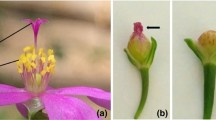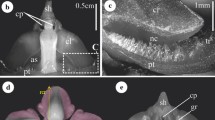Abstract
Entomophilous plants produce flowers with bright colours, patterns, and rewards like nectar, pollen, etc. for self-advertising. Many such plants only have pollen as a reward, so they deceive pollinators by appearing to offer more reward than is actually present. This is accomplished by hairy filaments, broad anther connectives, variously modified staminodes, etc. More than 20 angiosperm families have heteromorphic stamens, the significance of which has not been adequately studied. Their role with regard to Commelina diffusa, Dictyospermum montanum and Rhopalephora scaberrima of Commelinaceae is investigated here. These plants, apart from being nectarless, produce short-lived flowers and are an excellent system for studying the relevance of morphological adaptations in reproductive success. It has been suggested that the dimorphic anthers address the conflict of using pollen, the carriers of male gametes, as a reward to lure pollinators, thereby reducing the available gametes for fertilization. This is accomplished by functionally separating the anthers for ‘feeding’ and ‘pollinating’ purposes. Our study showed that while the feeding anthers infatuate the insects and are manipulated by them, the pollinating anthers succeed in maximizing pollen exports by using specific un-groomed ‘safe sites’ on the body of the insect to solve the conflict by using pollen as a reward.





Similar content being viewed by others
References
Barrett SCH (1985) Floral trimorphism and monomorphism in continental and island populations of Eichhornia paniculata (Spreng.) Solms. (Pontederiaceae). Biol J Linn Soc 25:41–60. https://doi.org/10.1111/j.1095-8312.1985.tb00385.x
Bowers KA (1975) The pollination ecology of Solanum rostratum (Solanaceae). Amer J Bot 62:633–638. https://doi.org/10.1002/j.1537-2197.1975.tb14094.x
Brantjes NBM (1982) Pollen placement and reproductive isolation between two Brazilian Polygala species (Polygalaceae). Pl Syst Evol 141:41–52. https://doi.org/10.1007/bf01006478
Brewbaker JL, Kwack BH (1964) The calcium ion and substances influencing pollen growth. In: Linskens HF (ed) Pollen physiology and fertilization. North-Holland Publishing Company, Amsterdam, pp 143–151
Buchmann SL (1983) Buzz pollination in angiosperms. In: Handbook of experimental pollination biology. Van Nostrand Reinhold Company, New York, pp 73–113
Buchmann SL (1987) The ecology of oil flowers and their bees. Annual Rev Ecol Syst 18:343–369. https://doi.org/10.1146/annurev.es.18.110187.002015
Dafni A (1984) Mimicry and deception in pollination. Annual Rev Ecol Syst 15:259–278
Darwin C (1862) Cambridge Digital Library. Available at: https://cudl.lib.cam.ac.uk/view/MS-DAR-00115-00166/1. Accessed 27 Mar 2018
Darwin F (1899) The botanical work of Darwin. Ann Bot (Oxford) 13:9–19
Dudash MR (1991) Plant size effects on female and male function in hermaphroditic Sabatia angularis (Gentianaceae). Ecology 72:1004–1012. https://doi.org/10.2307/1940600
Endress PK (1996) Diversity and evolutionary biology of tropical flowers. Cambridge University Press, Cambridge
Faden RB (1998) Commelinaceae. In: Kubitzki K (ed) Flowering plants monocotyledons. Springer, Berlin, pp 109–128
Faden RB (2000) Floral biology of Commelinaceae. In: Wilson KL, Morrison D (eds) Monocots: systematics and evolution. CSIRO Publishing, Melbourne, pp 309–317
Ferreira QIX, de Araújo P (2016) Economia de pólen favorecida pela heteranteria em Desmocelis villosa (Melastomataceae). Rodriguésia 67:347–355. https://doi.org/10.1590/2175-7860201667206
Forbes HO (1882) Two kinds of stamen with different functions in the same flower. Nature 26:386
Govaerts R, Faden RB (2015) World Checklist of Commelinaceae. Facilitated by the Royal Botanic Gardens, Kew
Howlett BG, Walker MK, Rader R, Butler RC, Newstrom-Lloyd LE, Teulon DAJ (2011) Can insect body pollen counts be used to estimate pollen deposition on pak choi stigmas. New Zealand Pl Protect 64:25–31
Hrycan WC, Davis AR (2005) Comparative structure and pollen production of the stamens and pollinator-deceptive staminodes of Commelina coelestis and C. dianthifolia (Commelinaceae). Ann Bot (Oxford) 95:1113–1130. https://doi.org/10.1093/aob/mci134
Jesson LK, Barrett SCH (2003) The comparative biology of mirror-image flowers. Int J Pl Sci 164:237–249. https://doi.org/10.1086/378537
Jesson LK, Barrett SCH (2005) Experimental tests of the function of mirror-image flowers. Biol J Linn Soc 85:167–179
Kimsey LS (1984) The behavioral and structural aspects of grooming and related activities in euglossine bees (Hymenoptera: Apidae). J Zool 204:541–550. https://doi.org/10.1111/j.1469-7998.1984.tb02386.x
Koch L, Lunau K, Wester P (2017) To be on the safe site—ungroomed spots on the bee’s body and their importance for pollination. PLoS ONE 12:e0182522. https://doi.org/10.1371/journal.pone.0182522
Lloyd DG (2000) The selection of social actions in families: III. Reproductively disabled individuals and organs. Evol Ecol Res 2:29–40
Lunau K (2006) Stamens and mimic stamens as components of floral color patterns. Bot Jahrb 127:13–41. https://doi.org/10.1127/0006-8152/2006/0127-0013
Luo Z, Zhang D, Renner SS (2008) Why two kinds of stamens in buzz-pollinated flowers? Experimental support for Darwin’s division-of-labor hypothesis. Funct Ecol 22:794–800. https://doi.org/10.1111/j.1365-2435.2008.01444.x
Lynch SP, Webster GL (1975) A new technique of preparing pollen for scanning electron microscopy. Grana 15:127–136
Macior LW (1982) Plant community and pollinator dynamics in the evolution of pollination mechanisms in Pedicularis (Scrophulariaceae). In: Armstrong A, Power JM, Richards AJ (eds) Pollination and evolution. Royal Botanic Gardens, Sydney, pp 29–45
Mattsson O (1976) The development of dimorphic pollen in Tripogandra (Commelinaceae). In: Ferguson IK, Muller J (eds) The evolutionary significance of the exine. Linnean Society Symposium series, vol. 1. Academic Press, New York, pp 163–183
McKone MJ, Webb CJ (1988) A difference in pollen size between the male and hermaphrodite flowers of two species of Apiaceae. Austral J Bot 36:331–337. https://doi.org/10.1071/bt9880331
Michener CD (2007) The bees of the world, 2nd edn. Johns Hopkins, Baltimore
Müller H (1881) Two kinds of stamens with different functions in the same flower. Nature 24:307–308. https://doi.org/10.1038/024307c0
Müller H (1882) Two kinds of stamens with different functions in the same flower. Nature 26:30
Müller F (1883) Two kinds of stamens with different functions in the same flower. Nature 27:364–365. https://doi.org/10.1038/027364b0
Oziegbe M, Akinlua IO, Olalekan AAH (2013) Comparative pollination role of stamens and breeding system in three species of Commelina (Commelinaceae) in Ile-Ife, Nigeria. Acta Bot Brasil 27:543–550. https://doi.org/10.1590/S0102-33062013000300012
Peter CI, Johnson SD (2008) Mimics and magnets: the importance of color and ecological facilitation in floral deception. Ecology 89:1583–1595. https://doi.org/10.1890/07-1098.1
Primack RB (1985) Longevity of individual flowers. Annual Rev Ecol Syst 16:15–37. https://doi.org/10.1146/annurev.es.16.110185.000311
Ronse De Craene LP, Smets EF (2001) Staminodes: their morphological and evolutionary significance. Bot Rev 67:351–402
Ronse De Craene LP, Iwamoto A, Bull-Hereñu K, Dos Santos P, Luna JA, Farrar J (2014) Understanding the structure of flowers—the wonderful tool of floral formulae: a response to Prenner & al. Taxon 63:1103–1111
Shivanna KR, Rangaswamy NS (1992) Pollen biology: a laboratory manual. Narosa Publishing House, New Delhi
Shore JS, Barrett SCH (1984) The effect of pollination intensity and incompatible pollen on fruit set in Turnera ulmifolia (Turneraceae). Canad J Bot 62:1298–1303
Simpson BB, Neff JL (1981) Floral rewards: alternatives to pollen and nectar. Ann Missouri Bot Gard 68:301–322. https://doi.org/10.2307/2398800
Simpson BB, Neff JL, Dieringer G (1986) Reproductive biology of Tinantia anomala (Commelinaceae). Bull Torrey Bot Club 113:149–158. https://doi.org/10.2307/2995939
Tang LL, Huang SQ (2007) Evidence for reductions in floral attractants with increased selfing rates in two heterandrous species. New Phytol 175:588–595. https://doi.org/10.1111/j.1469-8137.2007.02115.x
Thakar JD, Kunte K, Chauhan AK, Watve AV, Watve MG (2003) Nectarless flowers: ecological correlates and evolutionary stability. Oecologia 136:565–570. https://doi.org/10.1007/s00442-003-1304-6
Thorp RW (2000) The collection of pollen by bees. Pl Syst Evol 222:211–223. https://doi.org/10.1007/BF00984103
Ushimaru A, Watanabe T, Nakata K (2007) Colored floral organs influence pollinator behavior and pollen transfer in Commelina communis (Commelinaceae). Amer J Bot 94:249–258. https://doi.org/10.3732/ajb.94.2.249
Vallejo-Marín M, Manson JS, Thomson JD, Barrett SCH (2009) Division of labor within flowers: heteranthery, a floral strategy to reconcile contrasting pollen fates. J Evol Biol 22:828–839. https://doi.org/10.1111/j.1420-9101.2009.01693.x
Vogel S (1978) Evolutionary shifts from reward to deception in pollen flowers. In: The pollination of flowers by insects, Linnaean Society Symposium series. Academic Press, London, pp 89–96
Vogel S (1993) Beitrug bei Pflanzen: Die Tauschblumen. Abh Math-Naturwiss Kl Akad Wiss Mainz 1:1–48
Westerkamp CH (1996) Pollen in bee-flower relations some considerations on melittophily. Bot Acta 109:325–332. https://doi.org/10.1111/j.1438-8677.1996.tb00580.x
Woodcock TS, Larson BM, Kevan PG, Inouye DW, Lunau K (2014) Flies and flowers II: floral attractants and rewards. J Pollinat Ecol 12:63–94
Acknowledgements
The authors thank the Kerala State Council for Science Technology and Environment for a financial support in the form of fellowship (No. 001/FSHP-MAIN/2015/KSCSTE), and Dr. K.V. Mohanan (Professor, Retd.), Department of Botany, University of Calicut for statistical interpretations.
Author information
Authors and Affiliations
Contributions
Both authors contributed to the conception and design of the study. Data collection and analysis were performed by Veena V., and both authors participated in the interpretation of data. Both authors also assisted with final drafts and gave final approval for publication.
Corresponding author
Ethics declarations
Conflict of interest
The authors declare that they have no conflict of interest.
Ethical approval
There are no legal requirements for ethical approval for studying the materials in this study including flower-visiting insects.
Human and animal rights
No animals were harmed during the work.
Additional information
Handling Editor: Louis P. Ronse De Craene.
Publisher's Note
Springer Nature remains neutral with regard to jurisdictional claims in published maps and institutional affiliations.
Rights and permissions
About this article
Cite this article
Veena, V., Nampy, S. Heteromorphic stamen: a strategy in nectarless entomophilous plants to increase pollination efficiency? An investigation with regard to three species of Commelinaceae. Plant Syst Evol 306, 82 (2020). https://doi.org/10.1007/s00606-020-01710-7
Received:
Accepted:
Published:
DOI: https://doi.org/10.1007/s00606-020-01710-7




